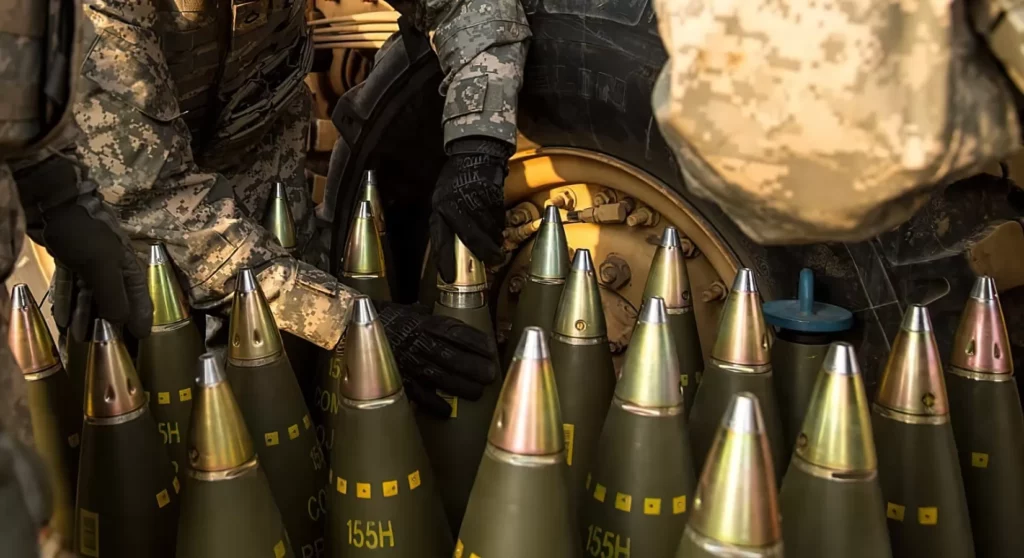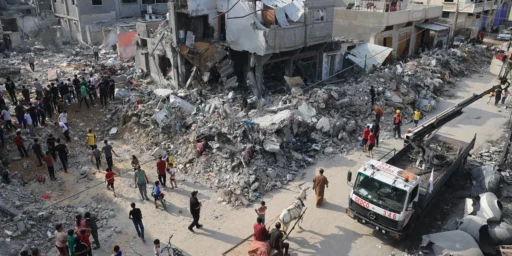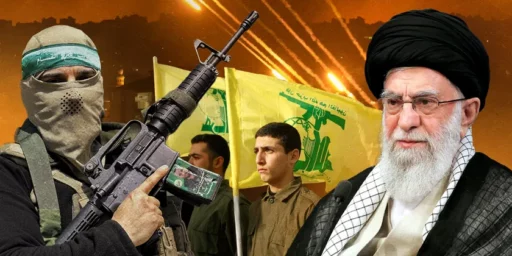The Fine Line Between Supporter and Co-Belligerent
America's involvement in the Israeli and Ukrainian war efforts is more than advertised.

While the Ukrainian and Israeli fights are different in many ways, they’re frequently tied together politically. And both demonstrate the complexity of providing major materiel, training, intelligence, and related support to belligerents while simultaneously avoiding being seen as a combatant. Two stories that emerged yesterday illustrate this.
AP (“Pentagon rushes defenses and advisers to Middle East as Israel’s ground assault in Gaza looms“):
The Pentagon has sent military advisers, including a Marine Corps general versed in urban warfare, to Israel to aid in its war planning and is speeding multiple sophisticated air defense systems to the Middle East days ahead of an anticipated ground assault into Gaza.
One of the officers leading the assistance is Marine Corps Lt. Gen. James Glynn, who previously helped lead special operations forces against the Islamic State and served in Fallujah, Iraq, during some of the most heated urban combat there, according to a U.S. official who was not authorized to discuss Glynn’s role and spoke on the condition of anonymity.
Glynn will also be advising on how to mitigate civilian casualties in urban warfare, the official said.
Israel is preparing a large-scale ground operation in an environment in which Hamas militants have had years to prepare tunnel networks and set traps throughout northern Gaza’s dense urban blocks. Glynn and the other military officers who are advising Israel “have experience that is appropriate to the sorts of operations that Israel is conducting,” National Security Council spokesman John Kirby said Monday. The advisers will not be engaged in the fighting, the unidentified U.S. official said.
Glynn is the 3-star Deputy Commandant for Manpower and Reserve Affairs. Previously, he was the commanding general of Marine Special Operations Command (MARSOC). That we’re advertising his role in planning the invasion is interesting.
But advising is a very small part of our role there:
The military team is one of many fast-moving pieces the Pentagon is getting in place to try and prevent the already intense conflict between Israel and Hamas from becoming a wider war. It also is trying to protect U.S. personnel, who in the last few days have come under repeated attacks that the Pentagon has said were likely endorsed by Iran.
Kirby said Iran was “in some cases actively facilitating these attacks and spurring on others who may want to exploit the conflict for their own good, or for that of Iran. We know that Iran’s goal is to maintain some level of deniability here. But we’re not going to allow them to do that.”
The White House said President Joe Biden spoke with Israeli Prime Minister Benjamin Netanyahu on Monday to update him on “U.S. support for Israel and ongoing efforts at regional deterrence, to include new U.S. military deployments.”
On Monday, the U.S. military garrison at an-Tanf, Syria, came under attack again, this time by two drones. The drones were shot down and no injuries were reported. It was the latest episode of more than a half-dozen times in the last week that U.S. military locations in the Middle East had come under rocket or drone attack since a deadly blast at a Gaza hospital.
Last Thursday the destroyer USS Carney shot down four land-attack cruise missiles launched from Yemen that the Pentagon has said were potentially headed toward Israel.
In response, over the weekend the Pentagon announced it was sending multiple Patriot missile defense system battalions and a Terminal High Altitude Area Defense system to the Middle East, as well as repositioning the Eisenhower strike group to the U.S. Central Command area of responsibility. The ship had previously been en route to the Eastern Mediterranean.
The shift means that the Navy will have a carrier strike group off the shore of Israel — the Ford carrier strike group — and another, the Eisenhower, potentially maneuvered to defend U.S. forces and Israel from the Red Sea or the Gulf of Oman.
“We’re going to continue to do what we need to do to protect and safeguard our forces and take all necessary measures,” Ryder said. “No one wants to see a wider regional conflict. But we will not hesitate to protect our forces.”
Aside from serving as a reminder that US forces are still in active, if relatively small-scale, conflict across the region this illustrates how intertwined all this fights are. Escalation is a real possibility here.
WaPo (“Ukrainian spies with deep ties to CIA wage shadow war against Russia“):
The cluttered car carrying a mother and her 12-year-old daughter seemed barely worth the attention of Russian security officials as it approached a border checkpoint. But the least conspicuous piece of luggage — a crate for a cat — was part of an elaborate, lethal plot. Ukrainian operatives had installed a hidden compartment in the pet carrier, according to security officials with knowledge of the operation, and used it to conceal components of a bomb.
Four weeks later, the device detonated just outside Moscow in an SUV being driven by the daughter of a Russian nationalist who had urged his country to “kill, kill, kill” Ukrainians, an explosion signaling that the heart of Russia would not be spared the carnage of war.
The operation was orchestrated by Ukraine’s domestic security service, the SBU, according to officials who provided details, including the use of the pet crate, that have not been previously disclosed. The August 2022 attack is part of a raging shadow war in which Ukraine’s spy services have also twice bombed the bridge connecting Russia to occupied Crimea, piloted drones into the roof of the Kremlin and blown holes in the hulls of Russian naval vessels in the Black Sea.
These operations have been cast as extreme measures Ukraine was forced to adopt in response to Russia’s invasion last year. In reality, they represent capabilities that Ukraine’s spy agencies have developed over nearly a decade — since Russia first seized Ukrainian territory in 2014 — a period during which the services also forged deep new bonds with the CIA.
The missions have involved elite teams of Ukrainian operatives drawn from directorates that were formed, trained and equipped in close partnership with the CIA, according to current and former Ukrainian and U.S. officials. Since 2015, the CIA has spent tens of millions of dollars to transform Ukraine’s Soviet-formed services into potent allies against Moscow, officials said. The agency has provided Ukraine with advanced surveillance systems, trained recruits at sites in Ukraine as well as the United States, built new headquarters for departments in Ukraine’s military intelligence agency, and shared intelligence on a scale that would have been unimaginable before Russia illegally annexed Crimea and fomented a separatist war in eastern Ukraine. The CIA maintains a significant presence in Kyiv, officials said.
The extent of the CIA’s involvement with Ukraine’s security services has not previously been disclosed. U.S. intelligence officials stressed that the agency has had no involvement in targeted killing operations by Ukrainian agencies, and that its work has focused on bolstering those services’ abilities to gather intelligence on a dangerous adversary. A senior intelligence official said that “any potential operational concerns have been conveyed clearly to the Ukrainian services.”
Many of Ukraine’s clandestine operations have had clear military objectives and contributed to the country’s defense. The car bombing that killed Daria Dugina, however, underscored Ukraine’s embrace of what officials in Kyiv refer to as “liquidations” as a weapon of war. Over the past 20 months, the SBU and its military counterpart, the GUR, have carried out dozens of assassinations against Russian officials in occupied territories, alleged Ukrainian collaborators, military officers behind the front lines and prominent war supporters deep inside Russia. Those killed include a former Russian submarine commander jogging in a park in the southern Russian city of Krasnodar and a militant blogger at a cafe in St. Petersburg, according to Ukrainian and Western officials.
Ukraine’s affinity for lethal operations has complicated its collaboration with the CIA, raising concerns about agency complicity and creating unease among some officials in Kyiv and Washington.
Even those who seesuch lethal missions as defensible in wartime questionthe utility of certain strikes and decisions that led to the targeting of civilians including Dugina or her father, Alexander Dugin — who officials acknowledge was the intended mark — rather than Russians more directly linked to the war.
“We have too many enemies who are more important to neutralize,” said a high-ranking Ukraine security official. “People who launch missiles. People who committed atrocities in Bucha.” Killing the daughter of a pro-war firebrand is “very cynical,” the official said.
Others cited broader concerns about Ukraine’s cutthroat tactics that may seem justified now — especially against a country accused of widespread war atrocities — but could later prove difficult to rein in.
“We are seeing the birth of a set of intelligence services that are like Mossad in the 1970s,” said a former senior CIA official, referring to the Israeli spy service long accused of carrying out assassinations in other countries. Ukraine’s proficiency at such operations “has risks for Russia,” the official said, “but it carries broader risks as well.”
There’s a lot more, but you get the idea.
Here, we’re seeing the classic problem with proxy wars: the proxy almost always has different interests and values than the sponsor. But it also illustrates just how deeply the US military and intelligence community is involved in training and planning the Ukrainian fight.
In both cases, it would be perfectly reasonable for the other side to view the United States as an active belligerent in the conflict, with our military and intelligence assets legitimate targets. Indeed, that already seems to be happening in the Middle East, although our targetability there is overdetermined.
In both cases, the cause is just, with US support warranted on both values and national security grounds. In Ukraine, in particular, the Biden administration has clearly been cognizant of the risk of escalation, as evidenced by its being dragged very slowly and reluctantly in expanding the range and lethality of weapons being supplied. But I suspect that the general public sees our involvement as merely expensive, not risky.






Did you expect anything else.
You’re probably too young to remember this but I recall when we had half a million advisors in Vietnam.
@Dave Schuler: Yep, I was born more than a year after the Gulf of Tonkin incident. Still, we only had a few thousand advisors in Vietnam before we became open belligerents there. But, while I don’t think we’re on the same path, there are similarities: advisors become targets, which necessitates a larger security contingent, which becomes a bigger target, which necessitates a larger security contingent . . .
From a foreign policy perspective the middle east is a bad habit. In a world where there are at least two other far greater FP challenges facing the US, here we are again wasting resources and possibly human assets in a sand pit filled with vipers. Conceptually, Obama was correct in advocating a pivot to Asia, though that never occurred and both trump and Biden have reengaged in the middle east, negating whatever progress that was made.
Chinese expansionism and neo-Russian empire building are far more germane to our interests than the middle east. Our, one true interest was petroleum, but with the movement away from fossil fuels and the development other sources across the world, that is far less important.
There are clear rules as to what constitutes an active belligerent. The US isn’t one in either conflict.
Just as Iran isn’t an active belligerent in either conflict. And just as Russia and China weren’t active belligerents in Vietnam.
@Dave Schuler:
This, of course, is not true.
There were less than 25,000 military advisors in total before outright combat deployments began in 1965. The latter troops were never seen or presented as advisors.
@drj: For most of the history of IHL, those who violated the principles of neutrality–as we have clearly done in both conflicts–were considered belligerents. Post-WWII, the rules really aren’t at all clear. A pretty good summary here.
I tend to agree with the author that simply providing material support, including armaments, to a belligerent—especially one acting, as both Israel and Ukraine are, in self-defense—doesn’t cross the line into co-belligerent status. But actively participating in planning and targeting is another thing entirely.
We seem to be supplying Patriot and THAAD systems, 155mm ammunition, and gawd knows what else to Israel in preference to Ukraine. A Russian foreign policy triumph. And a shame, as in we should feel ashamed.
I read somewhere that missiles for the Israeli Iron Dome anti-missile system cost $40,00 apiece and that Hezbollah may have 100,00 dumb missiles stockpiled. I suspect we are putting a lot of diplomatic effort and military posturing into keeping Hezbollah out of this mess.
@gVOR10:
The Iron Dome system missiles are the Israeli Tamir SAM.
I’m pretty sure it can’t use other missiles.
As only Israel produces the Tamir, that at least won’t affect supplies to Ukraine.
The greater shame re. Ukraine is the continuing slow-walk “grandmothers footsteps” act of the US and Germany in particular re weapons systems.
US is now supplying ATACMS but still withholding the longer range variant; Germany still dithering about supplying Taurus.
No F-16s or Abrams till next year etc etc.
@Sleeping Dog:
Unfortunately, ME oil supply continues to be vital to the global economy; about a third of global crude oil production.
Cut that, oil and gas prices will go through the roof, and most of Asia and Europe collapse into recession.
Plus it’s still important for recycling oil revenues into dollars for the overall financial system.
There a good reasons why both Russia and China continue to nose around the region like curious coyotes.
@Sleeping Dog:
There are things other than oil per se happening in the ME, especially if you include the eastern Med, that interest the US. There’s competition to determine the dominant Sunni power – Egypt, Turkey, Saudi Arabia. There’s Iran vs. Israel and Iran vs. the KSA. There’s always the Suez Canal. There’s even Turkey and Greece a potential intra-NATO fight, and a potential water war between Egypt and Ethiopia. That’s a partial list. The region always finds new ways to cause trouble.
But of course the biggie is China. So long as the US can stop Chinese tankers from filling up in the Red Sea or the Gulf, that, on top of our dominance in the straits of Malacca, means we have China’s balls in our pocket. We want convenient air and naval bases because China wants convenient air and naval bases. That necessitates some degree of diplomatic, economic and military involvement with various unsavory regimes. Cold War 2.0.
@JohnSF:
Interesting thing I learned about the ATACMS missiles from a popular Ukrainian War youtuber is that although we supplied the shorter range version of this missile, it contains a stronger payload and that seems to have made all the difference in the attack that took out a disproportionate number of Russian helicopters and ammo dumps in the attack just a couple weeks back.
The Ukrainian Military received a ridiculously high roi on the ATACMS attack on the helicopter base, and I understand that these missiles are in short supply and they need to use them sparingly, but when they do, no joke, if they get half the bang for their buck as they did with the helicopter strikes then a surprising amount of damage can be achieved during each attack.
Watching the leaked video of the helicopter base burning had me going whoa, even the Russians had to admit that hurt instead of just stoically standing tall and brushing it off as not that big a deal.
Sorry for the thread drift folks.
My only comment on the U.S. continuing to position battleships and troops in proximity to Israel is something I said to myself a couple weeks back when I read about the U.S. Navy taking out some drones and other stuff that originated from places like Yemen, that we were only swatting this stuff out of the sky to prevent other actors in the region (Yemen, Syria, Iran, etc.) from succeeding in spinning things even more out of control than they are right now.
That was me pointing out that water is wet, which is why I originally held-off on making that comment before now, but yeah…the actions against the Yemen drones did not spook me into thinking we would see boots on the ground anytime soon.
Biden has not allowed rust to form on him as he now works to assist with two conflicts a world away from the United States, and is still very savvy in how far he will involve the U.S. military in any direct conflict between Israel and her enemies.
Of course, it says it almost all that unlike Trump, who would want to make the military dance only to his tune, because he feels he is smarter than “his generals,” and could prosecute two major conflicts using just his superior to everyone else brain power, that President Biden is actually listening to all the wise ladies and gentlemen he has surrounded himself with when it comes to how to proceed.
@James Joyner:
Let’s imagine, for a minute, what our view would be if the Russians did to us in Iraq what we are doing to the Russians in Ukraine. Possibly thousands of US troops killed by intelligence and advanced weaponry provided by Russia to Saddam grinding us into a bloody stalemate. What would the median American have thought of that? Or consider if Russia provided Syria with the means to attack US forces in that country (side note: we still have forces in Syria, and we don’t really have much legal right to be there). We would have been fucking apoplectic and would not be making academic arguments about who is and isn’t a belligerent.
As with most things, where one stands is where one sits.
@JohnSF:
The US doesn’t have many ATACMS. Less than 2k stockpiled from what I’ve read. We can’t produce a lot of these missiles quickly. There are hard limits on what the US can provide, and 2k weapons is a drop in the bucket for a major war like Ukraine-Russia. This is just another data point in my long jeremiad about the difficulty of sustaining a major war with anemic peacetime military production.
As for F-16’s and Abrams, those are complex weapon systems that require a lot of training for Ukraine to use and maintain. Then there is the heavy logistics and support tail. It’s a transition that cannot be done quickly.
And, fundamentally, the problem is that these weapons are not going to be decisive in the course of the war, especially given the very real throughput limitations. Most of this will be replacements for equipment already lost.
@Andy:
My impression is that we are waiting on a newer HIMARS munition that’s supposed to start production in January. I don’t know how quickly Lockheed-Martin can produce them, but I’d guess we’ll match outgoing with incoming inventory.
I’d also guess that F-16s and Abrams are less about the immediate conflict and more about strengthening Ukraine for the long term. I get the feeling US military and pols aren’t convinced Ukraine can eject the Russians from all their seized territory and are looking to a frozen conflict, but with a Ukraine capable of deterring further Russian aggression. We can turn Ukraine into another Israel – able to punch way above their weight.
@Andy:
It’s true that they will not be wunderwaffen, and that prolonged sustainment is probably more important than rapid delivery.
However, I seriously doubt the Abrams is an order of magnitude more complex to sustain than the variety of MBT Ukraine is already handling.
Setting up support systems gets done sooner if started earlier, is my main point.
Just as there is scant reason for Germany to continue dithering about Taurus.
And there seems no reason not to have supplied ATACMS sooner.
Though my greater concern is how much effort is being put into increasing 155mm shell supply, barrels, and spare parts for all sorts of other equipment that will be needed next year.
The lesson from the UK in major wars is that it often needs concerted ministerial level direction to bulldoze the obstacles, and the EU is simply not set up on a “command economy” basis that can direct production.
@Andy:
Didn’t they already do that in Korea and Vietnam? I seem to recall some MiG fighters were flown by Soviet pilots, too. I’m sure the USSR and China armed North Korea, and the USSR supplied North Vietnam and the guerrillas in the South.
I think you don’t go to war against a nuclear armed opponent, even if they are arming and passing intel to the smaller, non-nuclear country you’re fighting. BTW, at the time of the Korean war, china had no nukes yet. US and allied troops did fight Chinese soldiers and units there.
@Michael Reynolds:
The problem with this is that Putin shows little sign of desiring a “freeze” at all.
If he can keep the war going at a sustainable level for Russia, I suspect he anticipates being able to outlast the West and Ukraine.
I have serious doubts that the Ukrainian economy can sustain for more than a few years, shorn of the south coast and under periodic bombardment.
And because large scale private investment is not going to come to a Ukraine in a state of war, or even “frozen conflict”, the question of long-term will in the West to bear the burden of replacing the private investment needed for recovery with much larger levels of economic assistance arises.
Especially given the MAGA Republican mega-sulk on Ukraine.
@JohnSF:
I don’t think Russia is capable of much more than a frozen conflict long-term. I’m sure they’ll make mischief but I don’t see any more Russian columns heading for Kiev, not with a Ukrainian AF flying F-16s with US intel capabilities.
Russia has economic problems of its own, some a consequence of sanctions, some to do with demographics, a brain drain, long-term moves away from oil and gas, a probable collapse in the arms export market, dwindling foreign reserves and a worthless currency.
But yes, Ukraine will struggle economically. Europe is going to need to step up, this isn’t a job for the US alone. We need serious government support for private investment.
Still, I would not want to be playing Russia in a game of Risk. The Russian Black Sea fleet is a dead letter and Turkey is likely to be the dominant naval power there. The Baltic Sea is a NATO lake. Not to go all Mahan here, but there are limits on the power of a country without a navy. They’ve got 35,000 miles of border to at least make some effort to defend, no prospect of western money, and a future as the tail to China’s dog. Russia is poor and getting poorer, outclassed in everything but chess and caviar.
@JohnSF:
I think Mad Vlad figures he just needs to last until January 2025 for Benito to nix all aid to Ukraine.
@Michael Reynolds:
I hope you are correct, and I’m just being gloomy for a day.
But the social/political basis of Putin’s regime in elite interests, corruption, and public apathy, tempered by bouts of hyper-nationalism, looks as solid as ever.
And the hydrocarbon economy is holding up sufficient to rule out a failure in the year to five year span, given China’s quiet support,
Russia can’t win militarily; but Ukraine can still effectively lose politically if it’s economy crumbles.
Europe is already providing more assistance than the US: in disbursed monies roughly €150 billion as against €70 billion.
But this may not be enough to sustain the Ukrainian economy over up to a decade if Russia holds the south coast and a low-intensity war keeps going.
I still think the optimal policy is maximum military assistance now, aiming for a decisive outcome in the next year, or two.
This also means Europe needs to do much more in serious military-industrial projects NOW; the problem is the EU is not set up, or legally empowered, to undertake this off its own bat.
While multi-country partnerships keep splitting because France (rightly IMO) wants to build a European defence procurement/production system, while Germany is spooked by anything that is not NATO-centric.
In fact, Germany is still so skittish generally it’s ludicrous.
Others suspect France is just trying to engorge its munitions sector at their expenses.
And getting the UK into such a system is hampered by Brexit, the UK fixation on US alignment, Treasury reluctance to spend anything on anything, and the utter dysfunction of the current Conservative government which is unable to see past its own impending electoral doom.
So, right now, I’m not Mr Happy.
The encouraging part is that Ukrainian continues to edge forward, rather carefully, and work the Russian supply lines with artillery.
Whereas Russia has embarked on another insane “zerg rush” offensive of it’s own in Donbas, and it loosing local forces at a an astonishing rate there.
While Ukraine has crossed the lower Dnipro near Kherson, and continues to ship grain via the Black Sea.
@Michael Reynolds:
My understanding–purely academic, as I am not a connoisseur–is that Iran is considered to produce the best Beluga caviar in the world now. Followed by …Florida. Ok, sometimes Russia depending on who is doing the rating, but still…Russia, you are being out competed by a state most known for a mutant mouse and the propensity of it’s citizens to do insane things while on crystal meth.